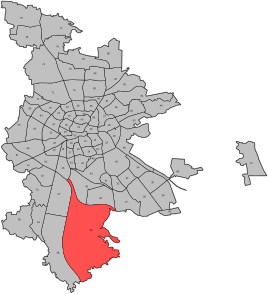Weiherhaus (Nuremberg)
|
Weiherhaus
Statistical District 492 City of Nuremberg
Coordinates: 49 ° 22 '17 " N , 11 ° 4' 44" E
|
|
|---|---|
| Height : | 332 m |
| Incorporation : | 1972 |
| Postal code : | 90455 |
| Area code : | 0911 |
|
Location of the statistical district 49 Kornburg, Worzeldorf, Weiherhaus in Nuremberg
|
|
Weiherhaus is a district in the south of Nuremberg and part of the statistical district 49 ( Kornburg, Worzeldorf ).
history
The oldest records of Weiherhaus date back to 1339. The district is on two ponds houses the family fish tank Fischbach back. The fish tanks protected the ponds that were created for extensive fish farming. In 1354 they sold this property to the city of Nuremberg, which had officials and tenants from 1476 live on the office building. In 1518 the city council sold the “Hof zum Weyerhaus” together with the old, imperial ponds and the city's own ponds to Hans Behaim the Younger , the son of the Nuremberg city architect Hans Beheim the Elder . Under his sons, the seat was "ruined and ruined" in the Second Margrave War on May 15, 1552. The rebuilt seat came to the heirs, including the Gwandschneider family. After their bankruptcy in 1609, a son-in-law, Georg Pfinzing von Henfenfeld , acquired the property, which also went bankrupt in 1619. Other members of the Pfinzing family bought the Weihergut and kept the pond running during the Thirty Years' War. From 1696 the current mansion was built, which contained an apartment for the fisherman on the ground floor. In 1714, the estate fell through marriage to Karl Benedikt Geuder von Heroldsberg (1670–1744), the foremost Losunger and Reichsschultheiß. Under him, the massive basement house was converted into a summer house with an upper floor made of half-timbered houses in 1728. In 1795, the Geuder sold the estate complex for 19,200 guilders to Karl Wilhelm von Welser , Nuremberg's city architect. At that time, in addition to the massive castle building, it also comprised a garden house, stables, a barn and a voit, day laborer and fisherman's house. At this point in time the ponds had largely been drained and turned into meadows or forests. The property was sold to the brothers Carl and Paul Christoph Oelhafen von Schöllenbach around 1812 . They smashed the property, sold the buildings individually to bourgeoisie and only kept the manor house in their hands, which was sold in 1830 to Sophie Maria Christina Scheurl von Defersdorf , who sold it to bourgeoisie in 1854. After several changes of ownership, Lothar von Faber followed in 1875 , whose family remained owners until 1952. The manor house, which was last renovated in 1986 by the Matzdorf family, still has stucco ceilings from the 18th century.
In 1972 Weiherhaus was incorporated.
geography
Neighboring districts are Pillenreuth in the north, Herpersdorf and Worzeldorf in the east and Gaulnhofen and Katzwang in the south. Weiherhaus is located on the Main-Danube Canal , which borders it to the west. The Marthweg connects Schwabach and Katzwang with Falkenheim and the Nuremberg Garden City at the Südfriedhof ; it leads directly to the Nürnberg-Königshof junction of the Südwesttangente and after this junction turns into Saarbrückener Straße.
Attractions
Weiherhaus Castle, a two-story building with a hipped roof, is located at An den Weihern 3 .
Parishes
- Evangelical Easter Church Worzeldorf
Connection to the VAG
- Bus route 51
Literature / web links
- Gustav Voit: Weiherhaus . In: Michael Diefenbacher , Rudolf Endres (Hrsg.): Stadtlexikon Nürnberg . 2nd, improved edition. W. Tümmels Verlag, Nuremberg 2000, ISBN 3-921590-69-8 ( complete edition online ).
Individual evidence
- ^ History of mansions according to Robert Giersch / Andreas Schlunk / Bertold von Haller: Castles and manors in the Nuremberg countryside



